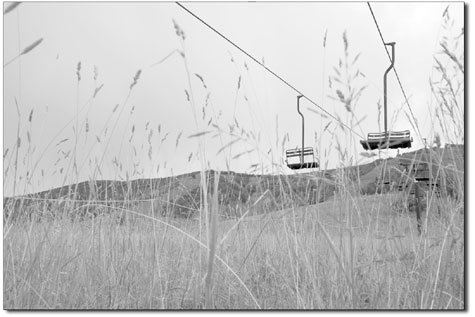| ||
| The warming of the ski industry Global warming puts a scary spin on the future of skiing SideStory: The greenhousing of national parks
by Allen Best In a best-case scenario, in which the global emissions of greenhouse gases are slowed, temperatures in many of Colorado’s ski communities are projected to rise 6 degrees by the year 2100. On the other hand, if greenhouse gases remain unchecked, temperatures in Colorado ski communities could rise 14 degrees by century’s end. A new study in Aspen has painted this dramatic global warming picture, and skiing is expected to shrink as a component of that town’s and Colorado’s economy. Aspen town leaders have been working with climate scientists and others during the last year in a groundbreaking effort. It may be the first time that broad, continent-and region-wide computer models have been used to deduce with precision the impacts of global warming in a very local area. Older computer models projecting impacts of global warming were so broad that they failed to even show the mountain ranges of the West. Newer models do, but remain coarse. Colorado is particularly difficult to model, said John Katzenberger, executive director of the Aspen Global Change Institute. “There are always limitations as you go to smaller and smaller regions,” he explained. “Colorado is particularly challenging, because it has storm tracks coming from different directions, and it also has the backbone of the continent. Whether storm tracks are on the east side or west side makes a lot of difference.” Because of the limitations of existing computer models in predicting climate in local areas, Aspen took the unusual step of integrating several different approaches. “They’re not precise for this small of an area,” Katzenberger said. “That’s why we used four methods, so we would come back at it from different angles and see if they came back with consistent messages.” The models did consistently show the same increments of warming, given certain levels of greenhouse gases – the more greenhouse gases that accumulate, the lesser the chances for skiable snow. In the worst-case scenario, skiing will disappear altogether. Concentrations of carbon dioxide, a key greenhouse gas, stood at 250 parts per million in the atmosphere 200 years ago, at the start of the Industrial Revolution. They are now at 379 parts. Many scientists say that 550 parts is the maximum that the Earth’s atmosphere can absorb without catastrophic consequences, and given current trajectories they’re likely to hit that in 2050. Aspen’s worst-case scenario assumes 900 parts per million by the end of the 21st century. However, Katzenberger also noted that 550 parts per million is not an inevitability. “It’s possible, if the world really wanted, it could do better than that,” he said. “And if it did so, the climate impacts could be greatly reduced.” Unlike future temperatures, the models for Aspen are unsure about future precipitation levels, mirroring the continent-wide models from which the local predictions were teased. “Given the current state of climate modeling, what precipitation will do in Northwest America, and with Aspen in particular, is really hard to say with any degree of confidence,” said Brian Lazard, a hydrologist with Stratus Consulting, a Boulder-based firm. “What we can say with a great deal of confidence is that the temperature will go up. It’s just a matter of how much.” This means that Aspen and many ski areas in Colorado will see less snow and more rain. And what snow they get will melt more rapidly, up to three weeks earlier, mirroring changes that have been documented in California’s Sierra Nevada during the last 50 years. Many of the study’s other key findings had been previously predicted, but the study gives them a stronger, scientific foundation. They include: • Warming will force some plant and animal species to ascend to higher elevations. Species of the alpine tundra such as ptarmigan and pika will face threats of localized extinction, something called extirpation. • Rising temperatures will increase the likelihood of insect outbreaks. Cold nights and winters help keep insect populations in check. Warmer nights and winters, along with longer, warmer summers, will increase the risk of pests to spruce-fir forest and to aspen groves. Bark beetles in pine trees are likely to be less checked. • Existing invasive species such as Canada thistle and leafy spurge will spread, and new non-native species may invade. • Ski season, if it remains, will occur at higher elevations, and during a shorter season. Whitewater seasons will be shorter, and water supplies will be more stressed. • Total precipitation has decreased 6 percent in the past 25 years, and at higher elevations of 10,600 feet, the precipitation has decreased 18 percent. In addition, the amount falling in the form of snow has decreased 18 percent. Results of this study, said Katzenberger, should be useful to community decision-makers as they adapt to climate changes. In general, the greater the warming, the more difficult and expensive adaptation to climate change will be. The study was the result of Aspen’s Canary Initiative, which was launched a year and a half ago by the city government. In the first part of that program, Aspen examined its own contribution to greenhouse gases and discovered that Aspen was responsible for roughly twice the per capita emissions of U.S. residents, mostly due to jet travel by visitors and its well-heeled residents. Aspen’s next step will be to compile a draft action plan, to determine what it can do better to reduce greenhouse gas emissions. Aside from its dependence on travel and its many large homes, the city and nearby Pitkin County have already taken many notable steps, among them adoption of building codes designed to maximize energy efficiency in buildings and a high reliance upon hydro and wind energy. The Canary Initiative is also hoping to spread the message to neighboring communities. It will sponsor a conference on Oct. 11-13 geared toward mountain and gateway towns. For more information, visit www.aspenglobalwarming.com.
|


